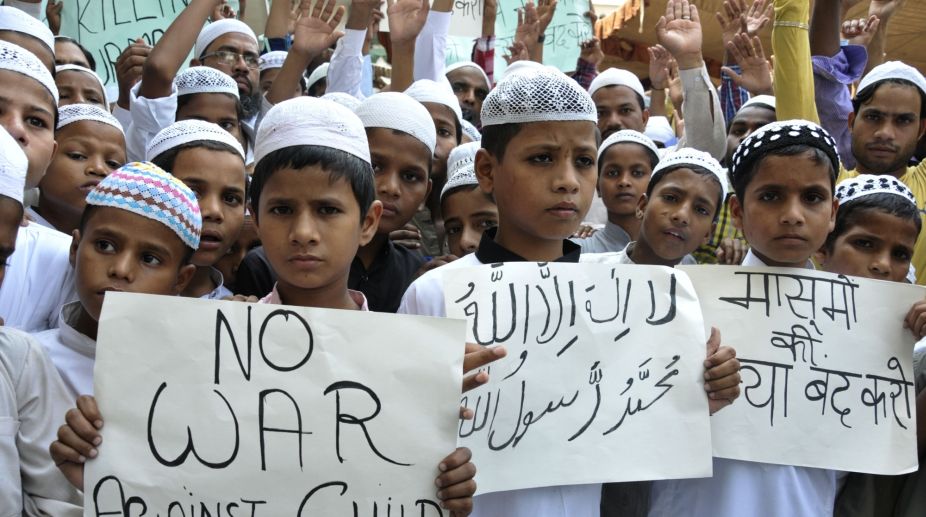RPF intercepts three Rohingyas at Agartala Railway Station
A collaborative effort of the RPF and the GRP uncovered suspicious activity during a routine inspection at the station.

Representational image (Photo: IANS)
The Supreme Court is due to rule on the fate of the Rohingyas facing deportation by the Indian government. We argue that the Rohingyas in India and Bangladesh have the right, under established principles of international refugee law, human rights law, and humanitarian law, not to return to Myanmar until hostilities have ceased and their safety can be guaranteed. They should also benefit from India’s longstanding principle of welcoming refugees.
On 8 September 2017, India rejected in the ‘Bali declaration’ of the World Parliamentary Forum a reference to Rohingya and human rights. Notably, India does not have a domestic law on refugees even as India is not a signatory to the Refugee convention of 1951 and the optional protocol. In the wilful absence of a legal definition of refugee in India, the Supreme Court in the Assam Mahasangha case clubbed “illegal migrants” to India as an “aggression on the state”.
No wonder, the government plans to deport on “security” grounds some 40,000 Rohingyas living in India. The Indian courts and the government have both taken a thought-out stand on the Rohingyas and other Muslim refugees.
Advertisement
Given the lack of a domestic law and the apathy to international law on refugees, India does not have to officially provide any relief to the Rohingya refugees. Consequently, they live in abject poverty in slums of Muslimmajority areas of Delhi, Telengana, Jammu and West Bengal. The UNHCR in 2016 however said that India has always respected the principle of non-refoulement – not sending back refugees to a place where they face danger.
Rohingyas have been severely persecuted in Myanmar in the last four decades. The situation has worsened in the last five years. Myanmar has created a so-called “lockdown zone” or “area clearance operation zone” between Taungpyoletwea and Maungdaw.
These are virtually internment camps. Tens of thousands of Rohingyas have fled to Bangladesh. Bangladesh too considers them as unwanted migrants, yet has hosted about 500,000 Rohingyas over the years. Like India, the Prime Minister of Bangladesh, Sheikh Hasina, has denied that more Rohingyas are inbound.
At any rate, for her, Rohingya are a problem for Myanmar and the United Nations to handle. The economic condition of Rohingyas in Bangladeshi camps is grim. In search of better livelihood, they have been taking risky sea voyages to south east Asian countries such as Thailand, Malaysia and Indonesia, as well as Australia. Many Rohingyas have been trafficked via Thailand to various countries to work as bonded labour. Many of them have died on the high seas and were killed while crossing the Thailand Malaysia border.
In 2017, several Muslim majority nations in Asia have spoken of the plight of the Rohingya. While the Malaysian Prime Minister spoke against the treatment of the Rohingya, the Maldives has severed trade ties with Myanmar in protest. In India, the Rohingyas therefore face two problems: as refugees, they are seeking asylum, and as economic migrants, they want formal permission to work in a host country.
With the South East Asian countries and Australia clamping down on entry, India threatening to deport them, and Bangladesh refusing to accept them, the Rohingyas are running out of options to find a safe, secure and economically viable territory to live in. Surprisingly, ASEAN of which Myanmar is a member has been mute since 2009. The triangular ethnic conflict between the majority Burmese, Rakhine Buddhists and minority Muslims, including Rohingyas, has fomented the political crisis in western Myanmar. Rohingyas were offered full and equal citizenship after Burma became independent in 1948. But Burmese nationalists and General Ne Win’s government drastically altered the status of Rohingyas in Myanmar.
Burmese nationalism portrays Burma as a land of Burman Buddhists. For it, Muslims are ethnically, linguistically and religiously different from the Burmese people. They are Bengalis who were brought in by the British colonisers. Burmese nationalism wants to create a Muslim-free Myanmar. Burmese Muslims contest this historical narrative.
They trace their history to the Arakan kingdom and region, and consider themselves as ethnically Arakanese. Burmese military captured power in 1962. Since then, it has been undertaking anti-Muslim actions.
In 1978, the Burmese army began a major offensive, referred to as Ye The Ha, against opposition groups in Arakan as well as the Rohingya mujahidin. Roughly 200,000 Muslims fled to Bangladesh. The Ne Win government passed an exclusionary Citizenship Act in 1982. This act created three categories of citizens – national, associate and naturalised.
Full national citizenship was reserved for 135 “national races” (official indigenous ethnic groups) or those who could prove their ancestry in Burma before 1823, that is, before the first Anglo-Burmese war (1824-1826). Rohingya is a self-descriptive term, yet they could claim to be an Arakanese ethnic group under the 1948 Union Citizenship (Election) Act.
1982 act which replaced Arakanese with Rakhine and excluded Rohingyas. Consequently, they found themselves as second class associate citizens. Rohingya were offered ‘white cards’ which conferred the right to vote. These cards were cancelled in 2015.
Rohingyas were forced to identify themselves as Bengalis and furnish evidence of three generations of continuous living in Myanmar for eligibility as naturalized citizens. In this process, 1.1 million Rohingyas living in Myanmar have been denied citizenship. The Rohingya refugee crisis requires urgent attention. Otherwise, the ongoing ethnic cleansing will snowball into full-fledged genocide.
(The writers are on the faculty of the Jindal Global Law School, Sonipat.)
Advertisement